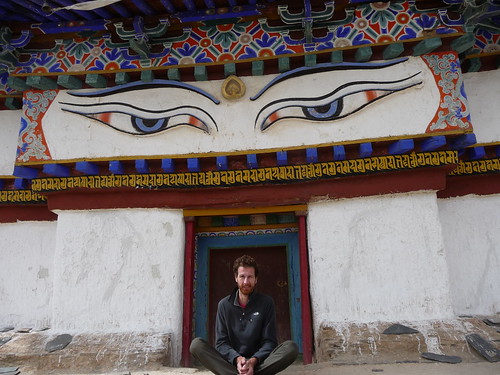
A couple of months ago I found a cheap ticket from Delhi to London, and decided to take a little detour from my Asia trip to visit some folks back in Europe. This turned out to be a bit of culture shock for me, for sure, and definitely a little more expensive than what I was accustomed to. Going into a coffee shop and paying more for a coffee as you'd pay for dinner over there takes a bit of getting used to.
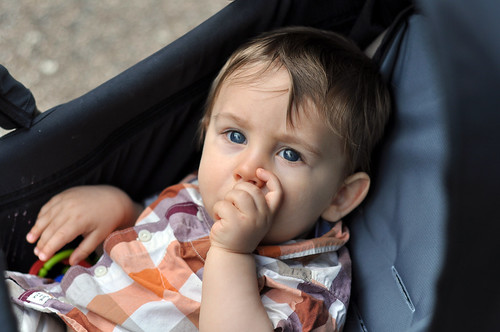
I started in London on May 22nd, staying with my friends Mark and Lee. Another couple of friends, Gay and Troy (and their cute kids Havana and Hudson), happened to be coming over to London to visit. I surprised them by showing up at their hotel one day (I thought Gay was going to pass out from the shock). The five of us had a fun week of just hanging out, walking around town, and having some good meals together. Besides that I spent a lot of time getting a new camera. On my Tibet trip almost everyone else had a digital SLR and I could see the difference between the pictures they were getting and the ones I was with my lowly pocket Lumix (which is a great camera). So after much research and shopping I ended up with a Nikon D90. I'm not on a huge materialist kick right now (carrying my possessions on my back most of the time) but I am in gadget love with it.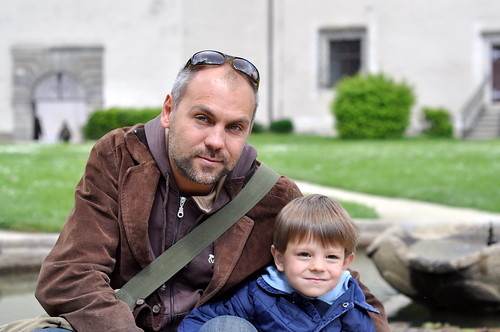
After London, I flew to the Czech Republic to visit my friend David, who I had met on my Annapurna trek in Nepal. I spent a few days staying with his wonderful family in Humpolec, which is a small village about an hour outside of Prague. We went around and saw some of the local castles and villages. I was also able to go to a bachelor party out in the woods for a friend of his and experience some real Czech camping cuisine (it's a blur of sausages and beer at this point).
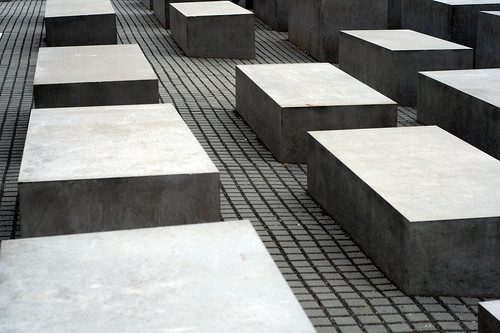
I was surprised at how expensive trains are in Europe and how cheap it is to fly. Most of my jumps between places were by EasyJet for about $70, but I did find a reasonable train ticket from Prague to Berlin, my next destination. Really loved Berlin - it's a relatively inexpensive place for people to live right now, so there is a vibrant arts scene going on and lots of young people from across Europe. I wandered around looking at galleries, stopping at cafes, and going out quite a bit. Mark's friend Allesandro took my out one night to a hipster East Berlin gay bar that was huge amount of fun. The picture above is of the new Holocaust Memorial near the Brandenburger Tor.
Next up was Amsterdam, where my friend Jordi and my meditation teacher Mark both live. I stayed for a night with Jordi at her brother's girlfriend, Gwendolyne's apartment, right on the Amstel River.
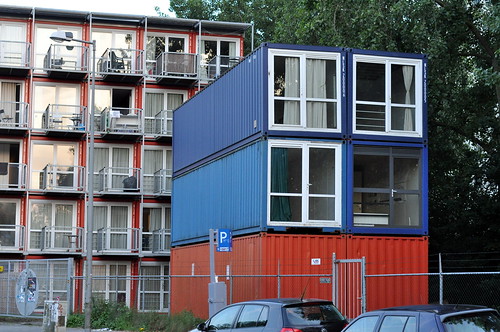
Then Jordi set me up with the coolest place to stay so far on my trip: a shipping container that her brother Ivar was renting but not staying in. Amsterdam has a major housing shortage right now, so these containers are used as temporary housing for students. They stack a bunch of the containers up on top of each other and add some basic scafolding to get around on them. The insides are like little IKEA showrooms, with full kitchens and bathrooms. My neighbors were the Hells Angels, who evidently have been heavily involved in some shady dealings in Amsterdam's red light district.

Amsterdam is one of the easiest cities to get around I've ever been in. As long as you don't try to drive - there are very few parking places anywhere in the city and it costs like 5 Euros an hour to park. It's the ideal place to ride a bike though - completely flat and compact. You can basically get across the city on a bike in less than 1/2 hour. I rented a bike and felt an incredible sense of freedom.

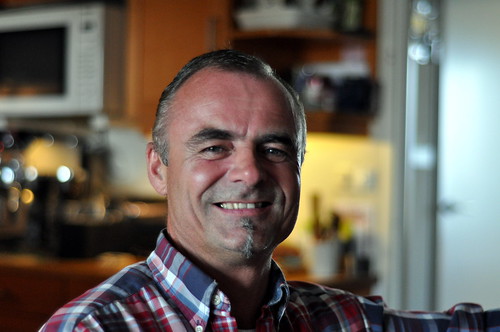
I was able to spend a lot of time with both Jordi and Mark. Jordi and I cooked a big Indian dinner for about 14 people (that took about 2 days) and Mark had a special meditation and teaching session on night when I was in town.

The last weekend I was there, Jordi and her friends took me down to Paris for an impromptu road trip. Lots of quality wandering around and I was able to charge up on steak tartare and roast duck before returning to my vegetarian ways in India.
My last couple of days were spent chilling out at my friends Shannon and Richard's house in Egham, back in England. I also met up in London with my friend Pete from the Tibet trip. Refilled on ear plugs, moisturizers and shampoo, I was ready for Asia again. Thanks to everyone for the hospitality in Europe!
Wednesday, June 24, 2009
Quick trip to Europe
Sunday, June 14, 2009
Lhasa
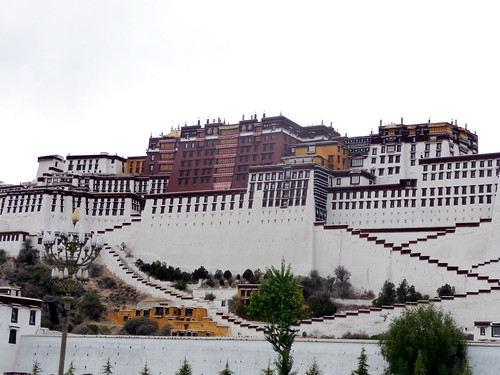
After Gyanze, the next day we drove for about 5 hours into Lhasa itself. I had heard reports that Lhasa was disappointing and that much of the culture was gone, but I found it a rich and fascinating place. It was easy to get off the main drag a bit, duck into a Tibetan tea house, and have a real encounter with Tibetans. I made a couple Tibetan friends this way, which really opened up the city for me.
The official tour lasted for two more days in Lhasa, and was packed seeing the major sights of the city. The first day we went to the iconic Potala Palace, which looms above the city and is the universal symbol of Lhasa. It used to be the residence of the Dalai Lama, but obviously that's not an option anymore, so it has been turned into a sort of museum. Though definitely not a living religious place, the riches and history contained inside are pretty amazing. There is just room after room of Buddha statues, huge and ornate tombs of previous Dalai Lamas, libraries of ancient Buddhist scriptures, and the preserved living quarters of the Dalai Lama.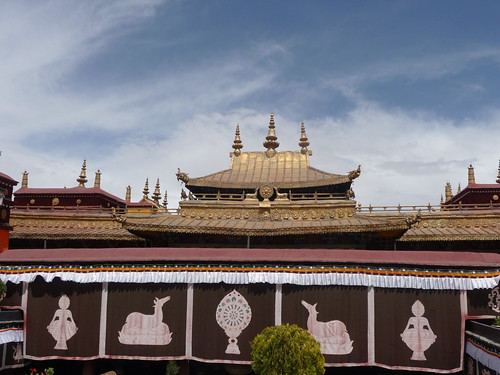
Next up was the Jokhang Temple. This is the spiritual heart of the city. Although the interior had been mostly destroyed by the Cultural Revolution and was rebuilt basically new, it is still immensely important to the Tibetan people.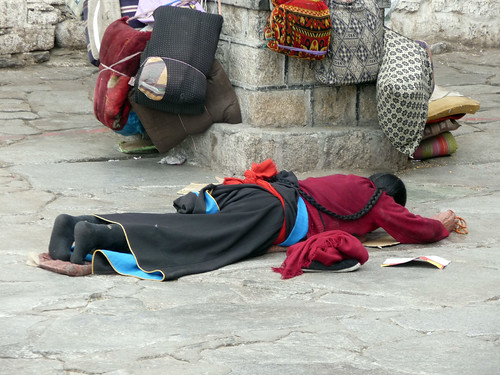
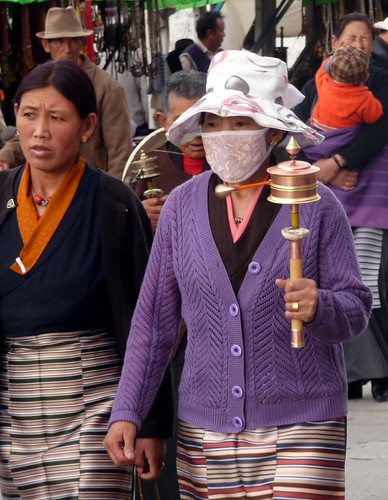
There was always a group of people performing prostrations on the pavement in front of the temple, and the central kora around the temple was constantly full of devout Tibetans swinging their prayer wheels. The people watching was just out of this world - Tibetans from all of the different regions, each with their unique traditional clothes: Kham, Ando, and others. I found myself returning again and again to this area to soak up the atmosphere (and eat some great mo-mos).
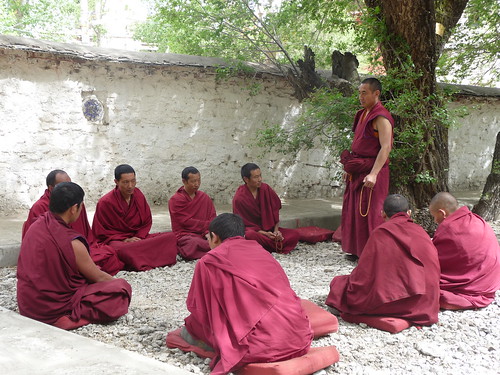
The final day of the tour we went to the two major monasteries near Lhasa: Drepung and Sera. These were largely rebuilt after the Cultural Revolution as well, so it was less interesting to me to see the temples themselves. We were able to see the debating monks at Sera, who were much more animated and exciting to watch than those at the earlier monastery in Shigatse.
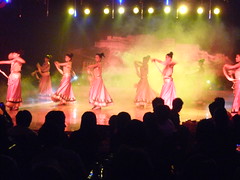
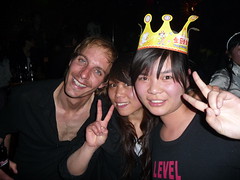
The last night of the tour, a bunch of us went clubbing to celebrate our friend Art's birthday. Going out in Lhasa was like nothing I've ever seen - though I think it was more of a Chinese experience than a Tibetan one. The first place we went had a huge stage where professional performers would come out and sing karaoke songs to us (my group went wild when this Chinese guy sang the 4 Non-Blondes song, "What's Going On", and "La Isla Bonita"). The karaoke was interspersed with large dance numbers featuring a ton of people in ethnic costumes, and also Chinese line-dancing where the audience came up on stage. We all went up to dance to one number and the police evidently came in and surrounded the stage - don't know what that was about.
The next place was more of a proper dance club, complete with stripper poles, rapping Chinese girls, and a ladyboy dancer behind the dj. I found myself dancing with a good-looking, extremely tall Chinese guy (as tall as me, how refreshing!) though he was too hyper of a dancer and I had to step off. At the end of the night there was a tent set up outside the club where you could have anything you imagined fried up: pork, chicken, liver, yak (of course), cauliflower, corn, etc. A little (deep-fried) slice of heaven.

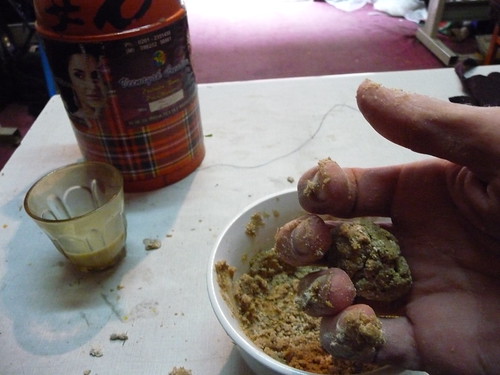
After the tour ended and I slept off my hangover, I spent the next few days on my own exploring the city. I made friends with a super-nice guy, Pon Tsok, who made Tibetan tapestries. I would go and visit him every morning in his shop and he would practice his English on me while feeding me tsampa and pouring me an ungodly amount of tea. To eat tasmpa, you start with barley flour and add a little yak butter tea to it. Then you work it with your fingers into a ball of dough and put it in your mouth. Not bad, though messy for the clumbsy Western fingers. Pon Tsok invited me to his English class one night, which was fun. I had other students passing me notes asking me to define what penquins and dolphins were (not sure if my drawing of a penguin helped - I think they thought it was a duck). After class a bunch of them took me out to dinner to practice more English.
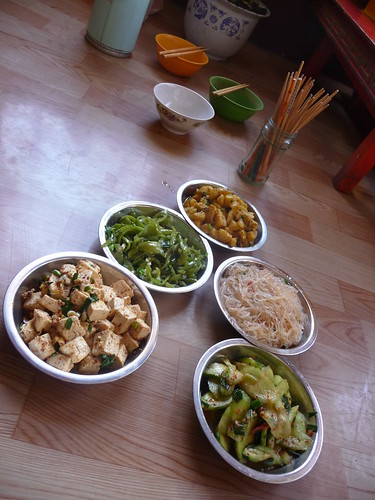
One my final day before I took off, I took a taxi out to the Ganden Monastery, about an hour outside of town. My taxi driver stopped off at a store to buy some juice and fruit, which seemed like a bit of a strange time to do some grocery shopping. Turns out that he's friends with the head lama at the monastery, and brought the food up to him as an offering. He led me into the lama's private apartment and I was able to have an audience with him for over 2 hours! This was the most amazing experience of the trip. The lama didn't speak much English, but we were able to communicate fairly well with gestures and a few words. He was very curious about life in America, and had such a joyful presence that I enjoyed simply being around him. His assistant cooked a delcious meal of stirfried vegetables and tofu, which I shared with the lama, the assistant and my taxi driver.

Afterwards, I walked around the monastery, which though much has been rebuilt, still shows the ruins of buildings that had been destroyed by the Chinese. Very sobering to see this reminder of what happened across the country to nearly all of the monasteries.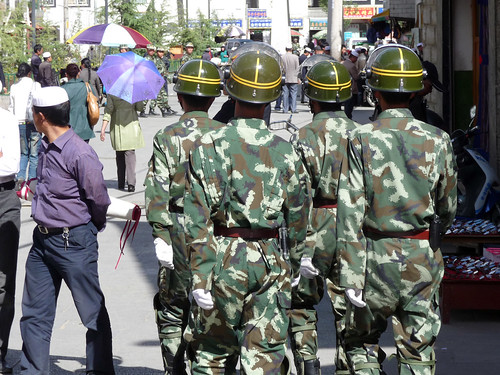
I was reminded throughout my trip, but especially in Lhasa, that this was a country under occupation. Many small groups of Chinese soldiers marched around the city center making their presence known - you would run into them every few minutes. I talked to a number of monks and other folks during the tour, and was frequently made aware of the threat of speaking out against the Chinese government, even among friends. One monk at a monastery knew no English but was quite good at pantomime. He mimed a monk talking too much, and then being led off in handcuffs. Other folks I talked to in a restaurant pointed at the ceiling and made the "shhhh" sign - there were microphones everywhere. I was told that the police had a habit of suddenly showing up and carting someone off if they talked about the Dalai Lama or the current political situation.
Another monk pointed at numerous places around a monastery, make a flattening motion with his hand indicating buildings being destroyed, and say one word: "Mao". Someone else told me of the visa system for monks: I was wondering why so few monks were living at the recently renovated monasteries, and it turns out it is because you need to be granted a "monastery visa" by the Chinese government. So the number of monks is strictly controlled, as is their make-up. We heard stories of informant monks who were planted by the Chinese inside of the monasteries.
All the while that the Tibetans communicated these stories of terrible destruction and repression to us, their eyes gleamed with good humor and happiness. Such was the contrast I saw over and over, where Tibetans would bear witness to the awful things that had happened to their country, but endure their hardship with pride and grace.
On the flight back to Kathmandu I randomly ran into two Austrian guys who had rescued me when I fell ill on the trail of the Helambu Trek in Nepal. A cool coincidence and good to catch up. We flew over the Himalayas and had a close, clear view of Mt. Everest as a conclusion to the trip.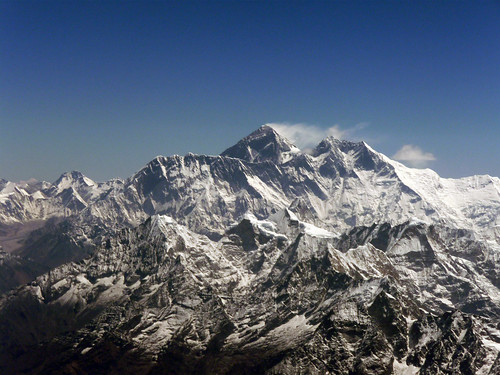
Monday, June 8, 2009
On the road to Lhasa

Tibet only recently opened after being closed to tourists due to the one-year anniversary of the unrest that occurred there last spring. When the ban was lifted, in typical fashion, China issued a press release saying that visitors had never been barred from entering the area in the first place! Things are pretty locked down right now and the only way to gain entry is to go on an organized tour. I booked the standard 8-day overland tour from Kathmandu, and was able to extend my stay for a few days afterwards in Lhasa. The trip had a great mix of people, most of whom were backpackers who would never of their own free will go on an organized tour.
We started early in the morning from Kathmandu and reached the border after about 4 hours driving along a windy mountain road. It took about a half hour to get through the Nepal side, and another 3 hours on the Chinese side. The swine flu scare had just hit and there was a hastily set up health checkpoint where we all had to get our temperature taken (and answer some questions about our health: were we "snivelling"? How about "psychotic"?). I was surprised by how disorganized it all was - I was expecting some kind of severe efficiency.
In a strange, welcome-to-Tibet moment, while it had been sunny when we went into the border crossing building, we came out into torrential rain. Our tour guide hurriedly divided us 4-at-a-time into Land Cruisers, which are the standard form of transportation in this area of the world. Evidently the roads used to be really bad around there but other than the first half day they turned out to be nice and new. China is investing a lot in infrastructure, at least on the route from Nepal. After some road construction delays, we pulled into a basic hotel in a truck stop of a town late at night.
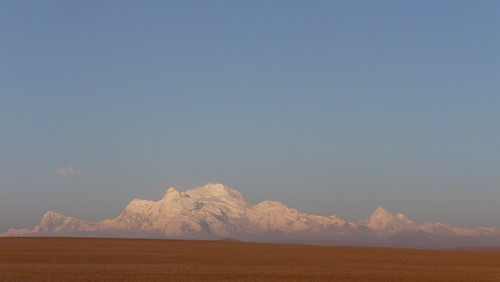
The next morning, after a breakfast of omelettes and Tibetan bread, we set out. The goal for that day was to make it to the small town of Lhatse. We climbed for a couple of hours through the mountains, crossed the very high (5,400m) Lalung-La pass, and found ourselves on the Tibetan Plateau. The scenery was unbelievable - flat barren plains for miles around, and mountains in all directions in the distance. The sky was enormous.
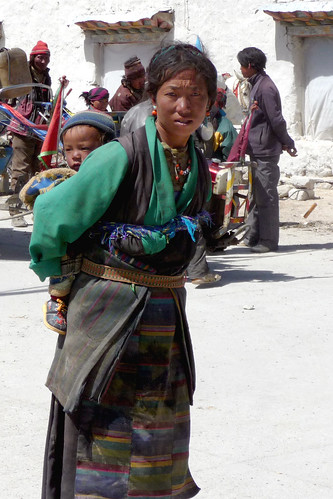
We stopped for lunch in a small village, and had our first real encounters with Tibetan culture. The people were extremely friendly, though shy and not terribly fond of having their picture taken. The women wore colorful patterned skirts and generally frumpy sweaters and jackets. The men dressed ruggedly in dark greys and purples, and had a bit of a cowboy look with wide-brimmed hats and boots. Horses and ox-drawn carts were common, as were enormous tractor-pulled flat beds.
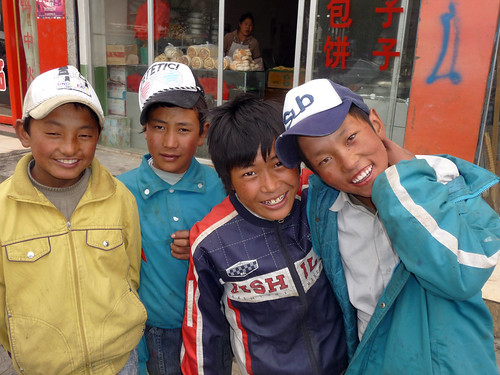
At lunchtime, we made the decision to continue on past Lhatse to spend the night in Shigatse, which was originally supposed to be our stop for the third night. This was great news, as I'd heard reports about how gross the hotel in Lhatse was supposed to be. Along the way, the Himalayas were in the distance, and were even able to see Mt. Everest (looked pretty small from there). After a brief stop in Lhatse to check it out, we continued on. It was in Lhatse where I noticed the strange effect my height had on people up there. The difference between my height and the average Tibetan´s was even greater than in India and Nepal. I attracted a giggling crowd of kids who couldn't stop pointing at me. This would become a bit ridiculous by the time I got to Lhasa! Nearly everyone would look at me, smile and chuckle, and often comment to me about how big I was. It was a good ice breaker if nothing else.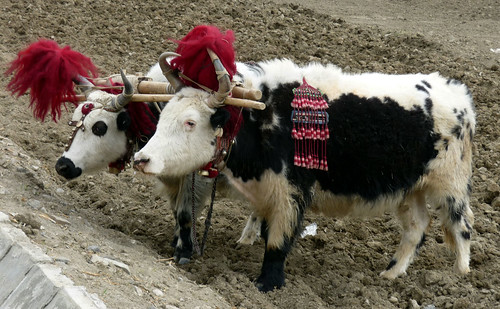
The rest of the day was a long drive through the plateau. We went through another mountain pass, and passed some nicely done-up yaks who were plowing a field. Our hotel in Shigatse was pretty plush - double rooms with a Western style bathroom complete with a bathtub. After dinner in a nearby restaurant, I called it a night, though evidently some others on the tour found a crazy karaoke nightclub. Shigatse was the first place where you could really see the extent of Chinese influence in Tibet. Tibet's second-largest city, it boasts a large, modern Chinese section of town, as well as a Tibetan old town. This pattern was repeated in the other cities we visited as well. The wealth on display in the Chinese area (huge stores full of motorbikes, appliances, etc) was in stark contrast to the modest means of most Tibetans we ran into. Many of the Tibetans had a weathered look about them, as if they had been through a lot of hardship, though almost universally the Tibetans had a cheerful attitude about them.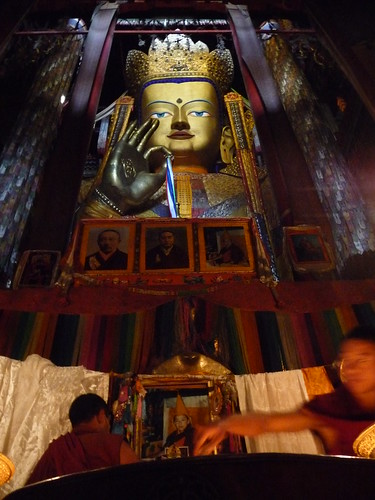
The next morning we visited the amazing Tashi Lhunpo Monastery, traditional home of the Panchen Lama. Monasteries in Tibet are bittersweet experiences, as many of them had been partially or completely destroyed by the Chinese during the excesses of the Cultural Revolution in the 1960s. Some had even been shelled by the Red Army, either during the initial takeover of Tibet in 1959 or later. In an ironic turn of events, Tibet has developed into a significant tourist draw for Chinese, and the reconstruction of the monasteries has been receiving quite a bit of funding. Many of the temples in the monasteries we visited were re-creations of the originals, including rebuilt Buddha statues and wall paintings. The main temple at Tashilhumpo, fortunately, had escaped destruction and we were able to view it as living and intact. Large bowls containing yak butter lamps illuminated an enormous Buddha overhead, as monks seated in one corner continuously chanted Buddhist prayers aloud.
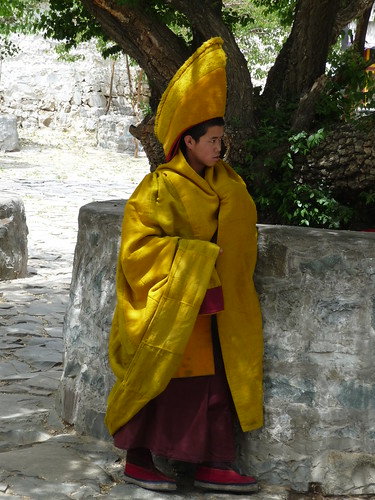
We wandered through this and other temples at the monastery, before stumbling upon a courtyard where young monks were practicing their knowledge of Buddhist scriptures by debating. Some of the arguments would get pretty lively, and be emphasized by loud claps of hands followed by a pointed hand gesture as one of the monks asked or answered a key question. Towards the end of the debate session, monks appeared dressed in the yellow robes and large plumed hats of the Gelugpa Buddhist sect. Afterwards, we were lucky to be allowed to sit in the back of a gathering hall as the monks had their lunchtime meal of tsampa (barley flour dough with yak butter tea) and prayers. One monk was designated as the entertainment for the session, and would pace back and forth making jokes and comments, punctuated by more claps and pointing. We had a strong suspicion that many of the jokes (in Tibetan) were directed towards us, but still felt very priviledged to be able to watch this.
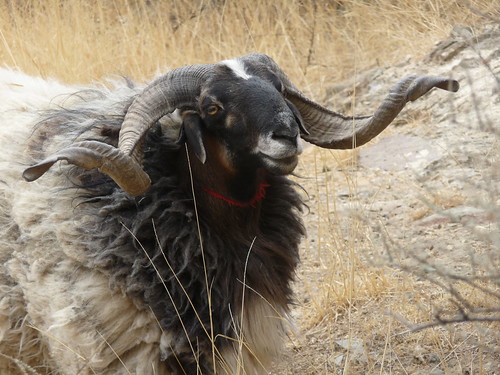
In the afternoon, the tour group split up, and I ended up having a great time checking out the area with Brit Pete Barlett. We completed the kora, or holy walking path, around the monastery and up into the hills, accompanied by an endless stream of local Tibetans. Also checked out the Tibetan old town, with its many white-washed houses and ornate wood-carved windows.
That night I had dinner with Raffaela from Italy, who was determined to try as many local specialities as possible - nearly all of which involved yak. It's hard to overstate how much yak is eaten up in Tibet. Luckily it's not that bad. Fairly close to beef unless you get some of the tougher parts. Raffaela ordered yak lung, and I ordered the rather pedestrian grilled yak. The waiter placed a dish in front of me, so I assumed it was my meal. After eating about a third of it, my grilled yak meal actually arrived and we realized I'd been tucking in to a big plate of lung! Kind of fatty, but otherwise pretty good.
On the grand scale of all things yak, yak cheeseburgers were the big winner, followed by yak steak, yak sizzler, and yak curry. At the other end of the spectrum would be yak butter tea, which is a staple drank often by most Tibetans. Salty, fatty and hard to describe, it doesn't taste at all like tea. The closest I can come is that it's like drinking a potato chip. I learned that if you finished a cup to be polite, Tibetan hospitality would ensure that your cup was quickly refilled again. So I had to avoid my natural tendency to clean my plate and empty my cup in order to avoid yak butter tea overload.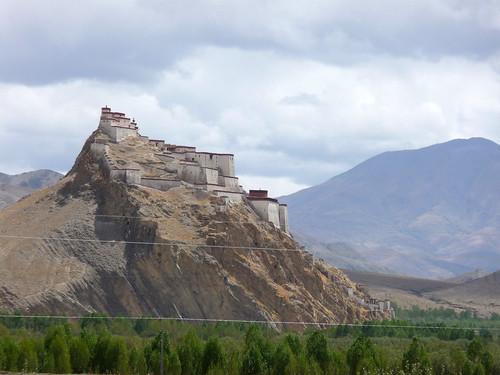
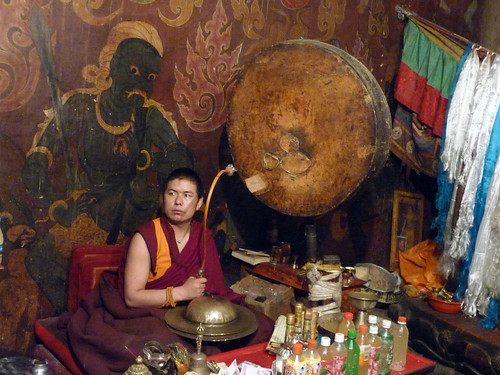
The next day we were off to the town of Gyanze, home of the Palcho Monastery. It seemed much less lively than the Tashi Lunpo Monastery, though I did get into a fight with a monk who wanted to make me pay twice to photograph inside the temple. Highlights were a cool, creepy room devoted to some of the darker Tantric deities, and the enormous Khumbum stupa. This is the largest stupa in Tibet - a nine story structure with over 70 different rooms full of paintings and sculptures of deities. It was pretty mind-boggling and beautiful. On top was a huge pair of Buddha eyes looking out on the nearby fortress.